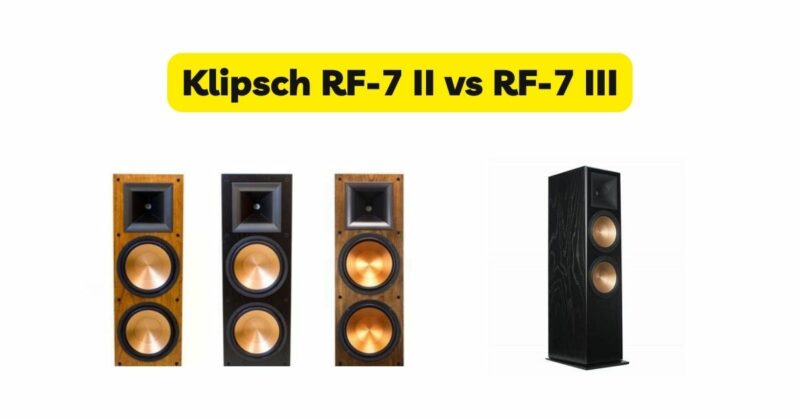Klipsch is a renowned name in the audio industry, known for its commitment to delivering immersive sound experiences. In this article, we delve into a comparison between two flagship floorstanding speakers from Klipsch: the Klipsch RF-7 II and the Klipsch RF-7 III. By examining their design, performance, features, and sonic characteristics, we aim to provide a comprehensive analysis of these exceptional speakers, shedding light on the evolutionary improvements made from the RF-7 II to the RF-7 III.
I. Design and Construction
Both the Klipsch RF-7 II and RF-7 III feature a robust and visually striking design that showcases Klipsch’s commitment to aesthetics and durability. The RF-7 II, introduced as a part of Klipsch’s Reference Series, sports a timeless appearance with its sleek lines, copper accents, and high-quality furniture-grade wood veneer. The RF-7 III, as the successor, retains the overall design language but incorporates modern enhancements, such as cleaner lines and improved fit and finish.In terms of construction, both speakers are built with high-quality materials and meticulous craftsmanship. The RF-7 III, however, benefits from refinements in its internal bracing and cabinet design, resulting in reduced resonance and improved overall rigidity. These enhancements contribute to a cleaner and more accurate sound reproduction.
II. Performance and Sound Quality
The performance and sound quality of the Klipsch RF-7 II and RF-7 III are where notable differences can be observed. The RF-7 II features a pair of 10-inch Cerametallic™ woofers and a 1.75-inch titanium diaphragm compression driver coupled to a Tractrix® horn. This driver configuration delivers dynamic and detailed sound reproduction, characterized by Klipsch’s hallmark efficiency and clarity. The RF-7 II offers robust bass response, smooth midrange, and extended high frequencies.The RF-7 III builds upon the strengths of its predecessor and introduces significant enhancements. It features updated woofers with an upgraded design, resulting in improved low-frequency extension and greater bass authority. The 1.75-inch titanium compression driver, coupled with an enhanced Tractrix horn, offers improved high-frequency dispersion and resolution. The RF-7 III delivers even greater dynamics, tighter bass, and increased detail retrieval, elevating the overall listening experience.
III. Technology and Features
Both the Klipsch RF-7 II and RF-7 III incorporate advanced technologies and features that contribute to their exceptional performance. Klipsch’s Tractrix horn design ensures precise and efficient sound dispersion, minimizing distortion and maximizing dynamics. The Cerametallic woofers, made of a lightweight and rigid material, enable accurate and controlled bass reproduction.The RF-7 III introduces Tractrix ports with enhanced aerodynamics, allowing for improved airflow and reduced turbulence. This refinement contributes to cleaner bass response and minimizes port noise. Additionally, the RF-7 III features upgraded crossover networks, carefully engineered to optimize the integration of its drivers and ensure seamless sonic coherence.
IV. Listening Experience and Room Placement
The Klipsch RF-7 II and RF-7 III are both designed to deliver powerful and immersive listening experiences. The RF-7 II is suitable for medium to large rooms, filling the space with its impactful sound signature. Its efficiency allows it to excel in both stereo music reproduction and home theater setups, delivering engaging performances across a wide range of genres.The RF-7 III takes the listening experience to the next level. With its improved bass extension and enhanced detail retrieval, it offers a more refined and immersive soundstage. The RF-7 III is particularly well-suited for larger rooms or dedicated home theater environments, where its increased dynamics and improved low-frequency response can shine.When it comes to room placement, both speakers benefit from being positioned away from boundaries to optimize their performance. Experimenting with speaker positioning and utilizing room treatments can further enhance the imaging, soundstage, and overall accuracy of both the RF-7 II and RF-7 III.
V. Price and Value
As flagship models, both the Klipsch RF-7 II and RF-7 III represent a higher price point in Klipsch’s product lineup. The RF-7 III, being the newer iteration, typically carries a higher price tag due to its enhanced features and performance improvements. However, it’s important to consider the value offered by each speaker in relation to your specific needs and budget.The RF-7 II, while not incorporating the latest advancements of the RF-7 III, still delivers a highly satisfying audio experience and may present a more cost-effective option for those seeking Klipsch’s flagship sound at a more accessible price point.
Conclusion
In conclusion, both the Klipsch RF-7 II and RF-7 III are exceptional floorstanding speakers that exemplify Klipsch’s commitment to delivering immersive sound experiences. The RF-7 III, as the newer model, introduces significant enhancements in performance, bass response, and overall sonic refinement. However, the RF-7 II remains a formidable option that delivers captivating sound reproduction and may present a compelling value proposition for those on a budget.Ultimately, the choice between the Klipsch RF-7 II and RF-7 III will depend on your specific requirements, budget, and listening preferences. Consider the size of your room, the desired level of bass performance, and your expectations for overall sound quality. Both speakers excel in their own right, providing a foundation for an immersive and engaging audio experience that will delight discerning audiophiles and home theater enthusiasts alike.

